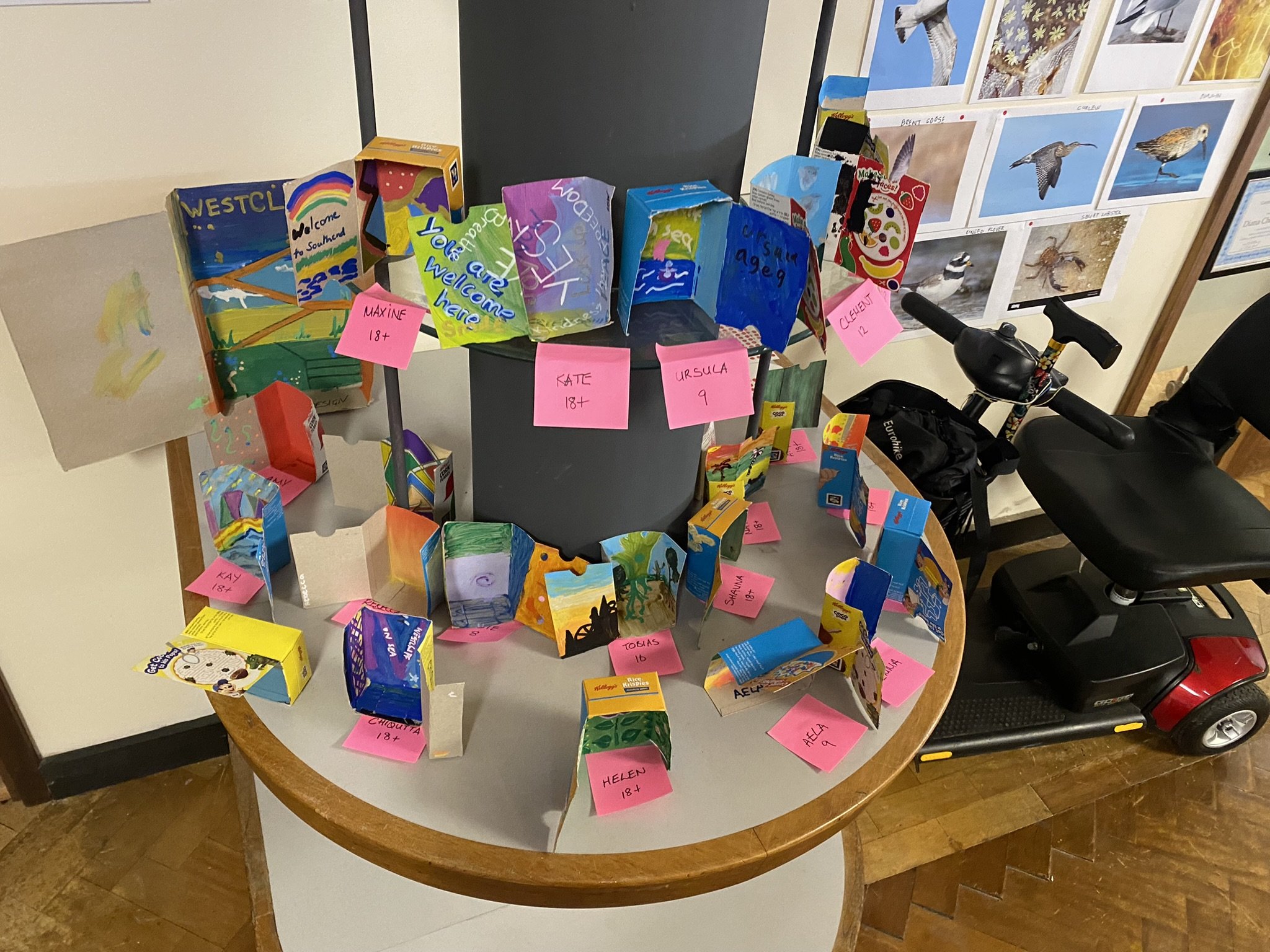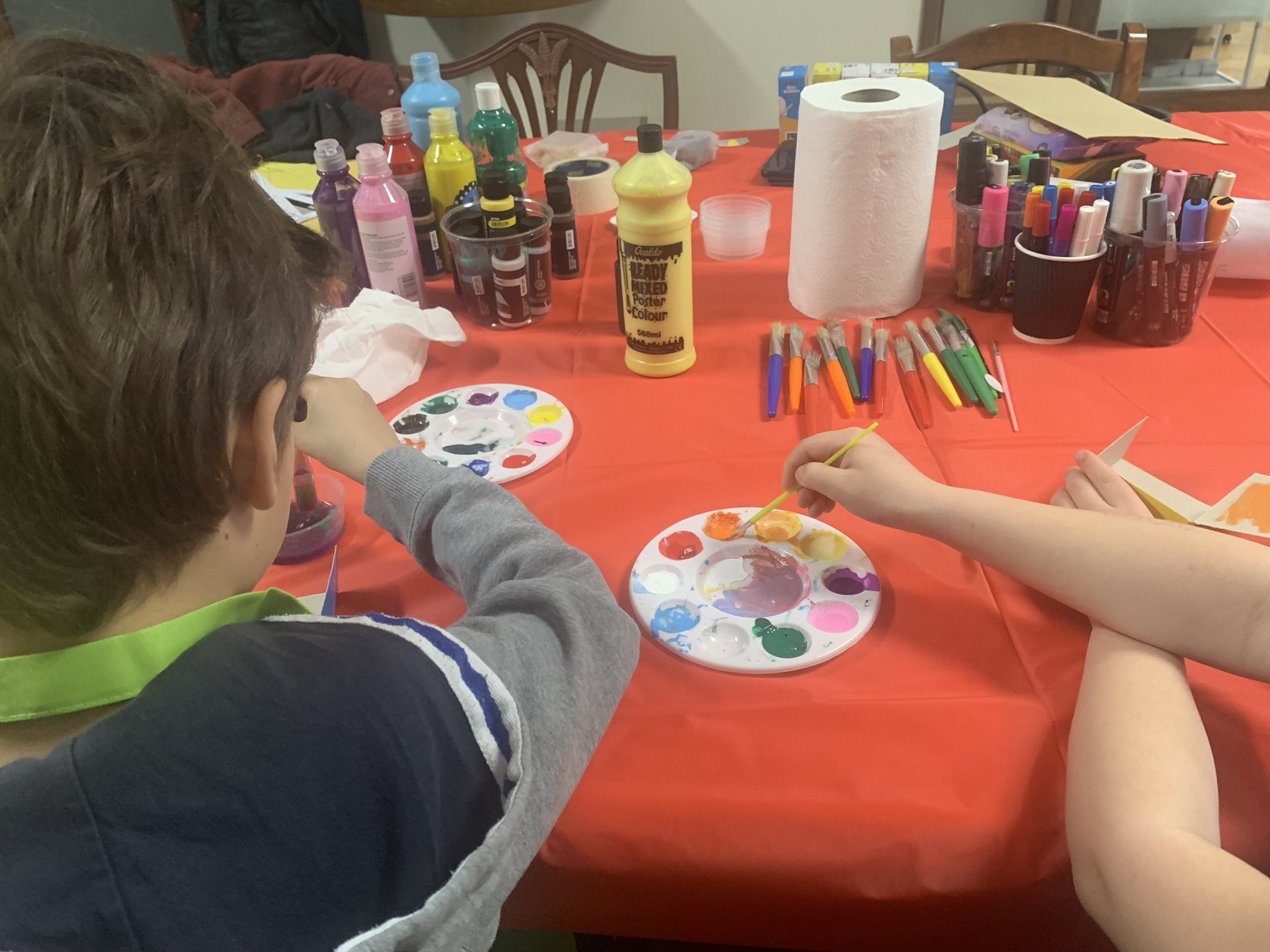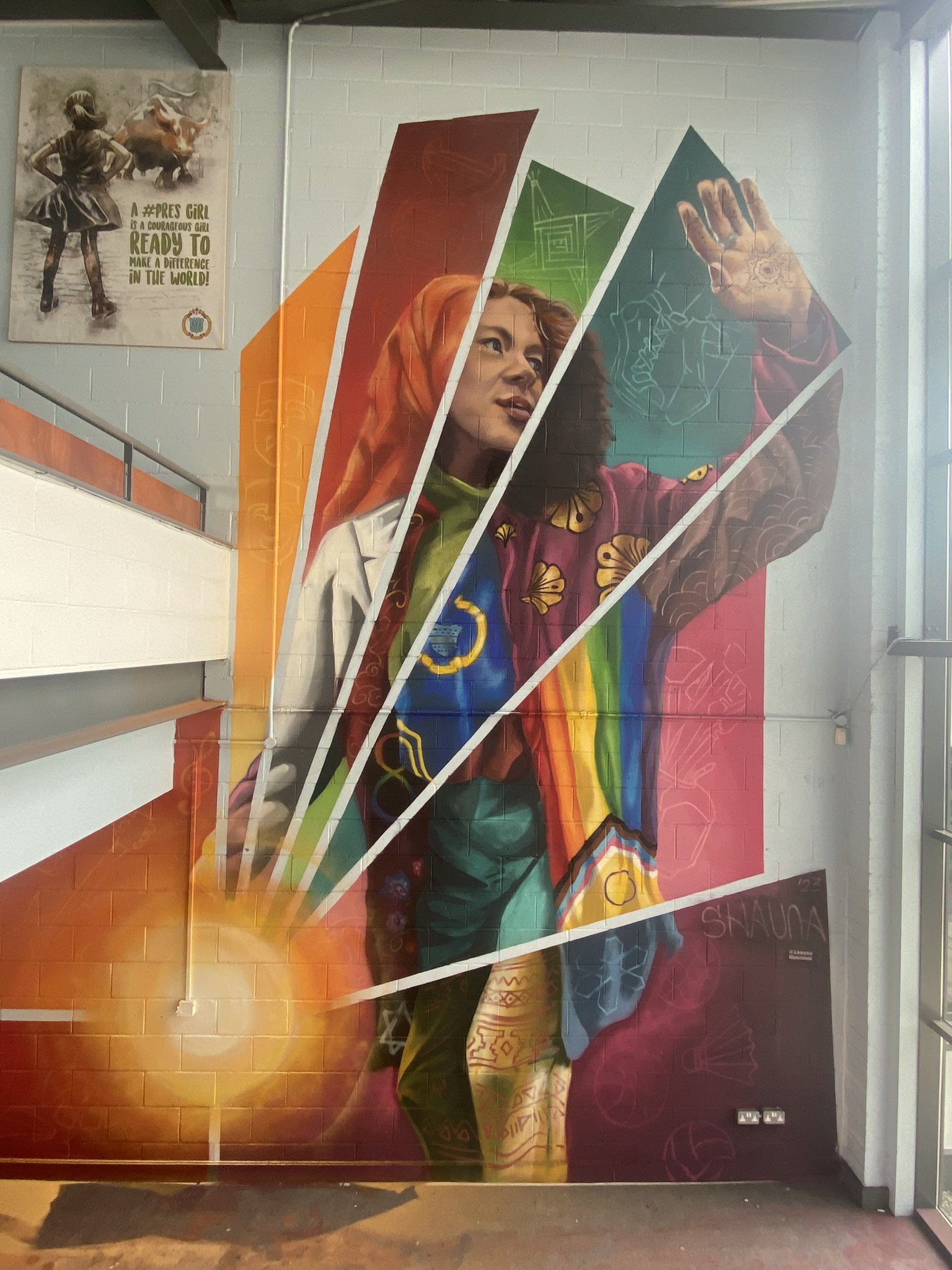Community Engagement
Community engagement is a core part of successful publicly funded mural projects. Getting local stakeholders on board from the start helps create a sense of ownership rather than imposition. People who live, work, or spend time near a mural often have a deep understanding of the area, and their insights can be invaluable in shaping a mural that reflects their community.
Community Engagement Murals by Shauna
Westcliff on Sea, Shore & Sky
Commissioned by Milton Community Partnership and supported by Southend City Council, MCP envisioned a mural capturing the unique history and ecosystem of the area.
Noticing that the three faces of the staircase resembled the shape of a cereal box, I developed a drop-in workshop at the Haven where local residents could design their own mini murals.
With the commissioning team’s enthusiasm for a nature theme, I included a section where participants could vote on their favorite local animals using sticker dots. The winning choices were then arranged in sequence from underwater to coast to sky, with a colour gradient shifting from day to night.
Conversations at the workshops revealed a strong desire to carve out a distinct identity for Westcliff, often overshadowed by neighbouring Southend and Leigh-on-Sea. To address this, I incorporated a placemaking signage element in my signature light illusion style.
Bloom As You Are
Commissioned by Oakfield Primary Academy. This 34m long mural is in a playground for 8 - 11 year olds in a school in Dartford. The interesting thing about working on these types projects is you need to balance the needs and wants of the school with something that young people actually think are cool and want to engage with.
For this engagement process I held workshops with a selection of young artists from 5 - 11 years old. For the younger group we printed out some animal pictures and asked the students to story-tell what they knew about them whilst their friends drew out the stories on one big piece of paper. For the older group we sparked new ideas using the a technique I learnt from the Artmongers and London School of Muralism, where everyone gave one idea for a mural design and then we turned the paper around so someone else had to finish your idea! This stopped the students from getting fixating on their own ideas to much and opened up creative flows.
The school wanted to include a slogan in the middle so I also asked them to tell us about some quotes that maybe their parents or carers said to them that were inspiring. But in the words of one young woman ‘I don’t want to do that coz it’s a bit naff’. You can’t win them all! But that comment did inform the design in the end. Originally we had discussed writing the school values on the wall, words like ‘Responsibility’ and ‘Equality’. But if picking an motivational slogan was uncool then the writing the values probably wouldn’t be that inspiring either! So instead we painted the symbols for the values like neon lights in the Oak Tree, so they were included, but in a way that the young people could connect with.
Shine Your Light
Commissioned by Colaiste Bríde secondary school in Dublin. Colaiste Bríde is a Presentation Sisters school, whose founder was Nano Nagle. The school wanted a mural representing the diversity of the student body inspired by their school slogan ‘Shine Your Light’, a reference to Nano’s famous lantern.
I worked with the schools ‘Arts Council’ on the design and what the school’s motto actually meant to them. I used the ‘Five Words’ technique, asking them to describe how they saw themselves in five words. The two themes that stood out were their culture background and their hobbies,
Together we looked at the different countries and activities represented by the school body and used a word/image association game using post-it notes to workshop visual elements to be included in the final mural.
What Does Community Engagement Look Like?
Community input in a mural project can take many forms, depending on the project goals. Often, funders or commissioning bodies request a ‘community engagement’ component, but this term can mean different things to different people. To avoid turning this into a simple "tick-the-box" exercise, it’s essential to define what engagement really means for your project. Is the goal to guide the design, build community buy-in, foster pride, share skills, or simply address potential concerns? Any of these can be valid objectives—as long as everyone agrees on the types of outcomes they’d like to see.
Community-Led Design
This approach invites the community to shape the theme and look of the artwork. Here, the artist’s role is to facilitate discussions and workshops, allowing the mural’s concept and content to emerge from those conversations. It’s the most open-ended form of engagement and usually requires multiple sessions to build out ideas.
Community-Informed Design
If there’s already a design direction in place but input from the community is still welcomed, this is a hybrid model. Artists often submit an initial design during the selection process, while the commissioning body still wants a level of community engagement. Workshops in this model allow stakeholders to contribute to elements of the design while preserving the artist’s original concept and style.
Community-Selected Design
For projects with limited capacity for in-depth community engagement, a simpler option is inviting local people to vote on proposed designs or color schemes, often through an open day or an online poll. This can still foster a sense of involvement even without intensive participation.
Collaborative Making
Some projects involve the community not just in the design but in the installation as well. This might include a community cleaning and painting day to kick off the project or a varnishing day to finish it. Smaller groups or individuals may also be taken on board to be taught how to do more complex work, creating an opportunity for skill-sharing or mentorship, particularly for young or emerging artists. In some cases, large groups contribute by creating smaller pieces that become part of a larger installation, such as in mosaics or yarn-bombing.
Each of these approaches has its place, and the most important thing is for all parties to be clear on what type of engagement makes sense for the project.
Sample Community Engagement Workshop Ideas
Every project is different. So is every workshop.
The best community engagement is tailored to the site and stakeholders your mural serves.
But here’s a couple tried and tested workshops ideas we love!
Sticker Boards and Sticker Choices
One of the easiest and most effective tools to understand group priorities is the use of sticker choices. You could put a series of images or themes on the wall and ask participants to vote for the ones that resonate most with them. A great technique is to vote with proximity, the closer the sticker is to the choice the stronger the feeling towards it. This can also be translated to an X-Y axis for more nuanced and specific choices.
An example could be; vote from left to right how important ‘local stories’ are to a project and vote from bottom to top how important ‘visuals and aesthetics’ are.
If you have a multi-generational group or a mix of stakeholders from different community groups, you can colour code the stickers to see if there are any trends to discuss. Do the older groups and younger groups vote differently? Maybe that’s a topic for discussion. Another good ice-breaker is to ask any outliers if they’d like to explain their view-points and see whether that sparks a conversation.
Storytelling through Collage
Allowing pictures to speak for us can be a powerful tool in addressing nerves or awkwardness in a workshop. A nice approach is collaborative collage in response to meaningful questions. Hang some boards or large sheets of paper on the wall and ask participants to find an image in a stack of magazines that they feel represents their answer.
For example, you could ask ‘find a image that represents how you feel about this town’ or ‘add a picture that speaks to your fears about this project’. Give participants time to stick their pictures up and then ask them to talk about their selection. You can add text from the conversation to add context to the images. Repeat for a few different topics. You’ll find that connections between experiences begin to form naturally and themes emerge. You also have a handy visual summary to refer back to.
Wool Maps
Inspired by the Identity Tapestry by Mary Corey March. Set up a wooden board with a series of nails or protrusions, each labelled with an outcome, a fear, a topic, a theme for the project. Attach balls of wool on one end and encourage participants to tell their story in relation to the project by wrapping wool around the labelled nails that matter for them. You could include personal markers if you want like age range, gender or ethnicity. Or you could let different coloured wool stand in for ways people define themselves ‘parent, creative, striving, tired’. Maybe give people a prompt at the end point ‘How do you feel now you’ve completed your map’, and ask them to write it on a post it note and pop it in a sealed box.
This project takes a little more setting up so it’s best suited to an engagement space where people have time to linger, perhaps you have a workshop in a cafe but the Wool Map can stay up for a week with a sign invited people to contribute.
Post-it Note Ice Breakers
A simple but effective method to drill down into the most prescient subjects on people’s minds. Set up four or five question sections in your workshop room and give you participants 15-20 minutes to think about the prompts. In turn move around the room and get your participants to stick their post-it response on the wall with a short explanation of what it means. After everyone has had the chance to talk, bring out some tea and biscuits and give everyone two sticker dots per question. Participants can vote for their two most relevant per question (but not their own!) and tend to start chatting amongst themselves. After about ten minutes address the most popular answers to start reaching a group consensus on your creative direction.





